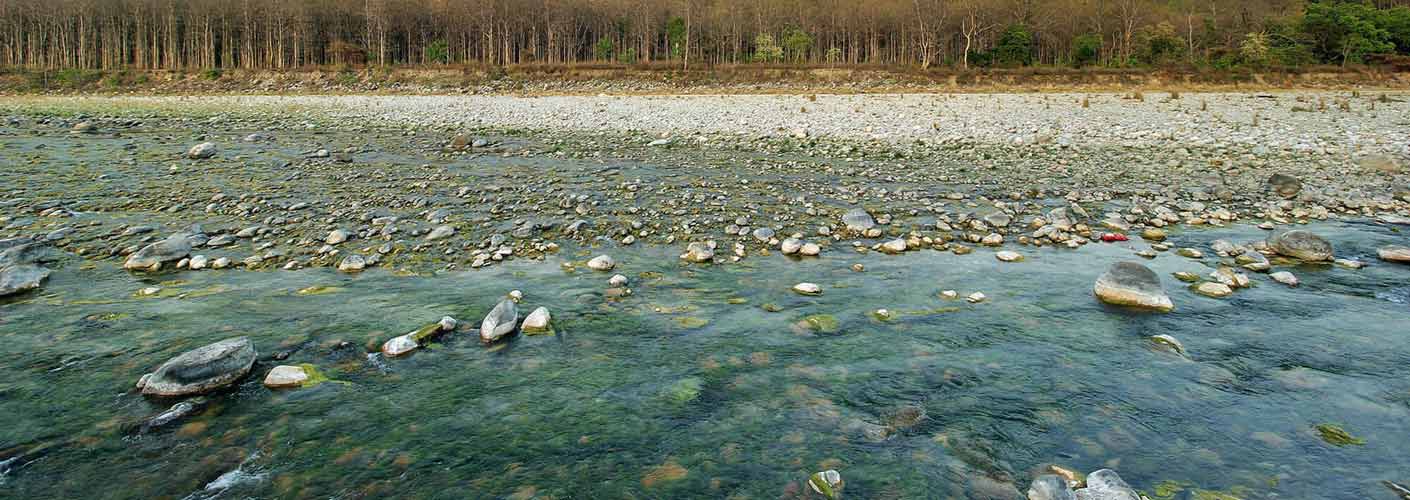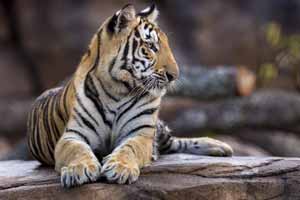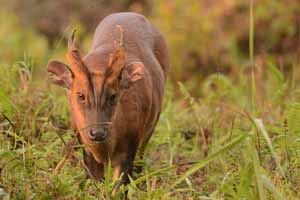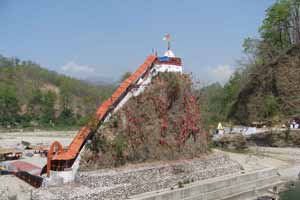
Corbett Rivers
Corbett National Park has been a haunt for tourists and wildlife lovers for a long time. For the survival of such a remarkable gamut of floral and faunal species in Corbett National Park, water is a crucial factor. The Ramganga river forms the most prominent hydrological resource, supplemented by tributaries, most prominent of which are the Sonanadi, Mandal and Palain rivers. The river Kosi runs proximate to the Park and is also a significant water resource for nearby areas. Wildlife is dependent on rivers, more so in the dry season, for they provide drinking water and also form home to several key aquatic species.
Water is essential for the survival of the spectacular avifaunal diversity present in the Corbett National Park. Such a remarkable gamut of flora and fauna species in the park is seen just because of the mighty rivers flowing through the park that plays a crucial role in shaping the biodiversity. The Ramganga river (West) along with its significant tributaries Sonanadi, Palain and Mandal forms the prominent hydrological resource for the Corbett. The river Kosi also flows by national park and serves as the significant water resources for the nearby area. The major portion of the Corbett wild is situated on the bank of River Kosi. These water bodies shape the wide and varied aquatic life of the region. The precious wildlife of the Corbett is dependent on rivers as they provide drinking water for them especially in dry season. The river that flows in and around the Jim Corbett National Park are as follows:
Ramganga River
The Ramganga river Without the Ramganga river there would be no Corbett. It is the largest of the precious few perennial sources of water in the Park. In fact, for a brief period (from 1954 to 1957) the Park was known as Ramganga National Park. A rain-fed river originating near Gairsain in the Lesser Himalayas, the Ramganga traverses more than 100 km before entering Corbett near Marchula. Inside the Park it flows roughly from east to west for 40 km till Kalagarh where it enters the plains. During this run through the Park it gathers waters from the Palain, Mandal and Sonanadi rivers. A dam on the Ramganga at Kalagarh (built in the mid-1970s) forms a reservoir of about 80 sq. km. area, the backwaters of which reach till Dhikala. Downstream from Kalagarh the river meanders for another 300 The moon over Ramganga valleykm through the Indo-Gangetic plains and finally drains into the Ganga near Farrukhabad in Uttar Pradesh. The Ramganga is inhabited by key aquatic species like mahseer fish, the endangered gharials, mugger crocodiles, otters and turtles. Many species of birds, like kingfishers, fish-eagles, terns and storks depend on the Ramganga. During winters the Ramganga reservoir attracts many migratory bird species, especially waterbirds from Europe and Central Asia. The road from Dhangarhi to Dhikala runs along the Ramganga for most of its length. Forest Rest Houses at Gairal, Sarapduli, Khinanauli and Dhikala are situated alongside the Ramganga. The Dhikala watchtower is an ideal spot to view the Ramganga in the Patli Dun valley. At Crocodile Pool, High Bank and Champion’s Pool visitors can dismount from their vehicles and see the Ramganga closely. Kanda FRH, the highest rest house of the Park, provides a bird’s eye view of the Ramganga.
Sonanadi
The Sonanadi is an important tributary of the Ramganga. Named after this river the Sonanadi Wildlife Sanctuary adjoins Corbett National Park and forms an important part of the Corbett Tiger Reserve. The Sonanadi enters the Park from the northwest direction and meets the Ramganga at the reservoir. The name ‘Sonanadi’ means ‘river of gold’. At one time grains of gold, found in the alluvial deposits washed down from the higher areas, were extracted from the bed sand by sieving, washing and mercury treatment.
Kosi River
The Kosi is a perennial river that servers major portion of the Corbett’s wild as the Corbett wild use the Kosi river to quench their thirst. Eastern periphery of the park is fed by Kosi that flows from Mohan till Ramnagar via Dhikuli. Though, the Kosi does not enter the park boundary.
Sot
Sot’ is the local name for a seasonal stream. While traveling across the park you may cross several of these bouldery dry streams. Though most of them appear dry and lifeless, they are very important for Sot or seasonal streamthe Park ecology. Animals depend on these sots for their drinking water requirements for a good part of the year. There are some sots in Corbett that are perennial, important ones being Paterpani, Laldhang, Kothirao, Jhirna, Dhara and Garjia. Since water is a limiting factor, these perennial sots provide water to wildlife during pinch periods. Sots also form passageways for animals. Many of these sots are covered with thick growth of evergreen shrubs and bamboo clumps which form ideal shelter for many animals including the tiger.






